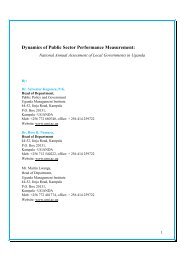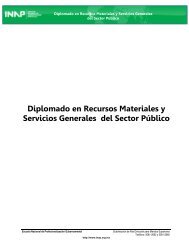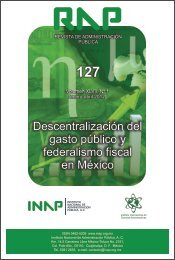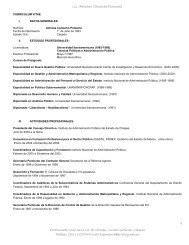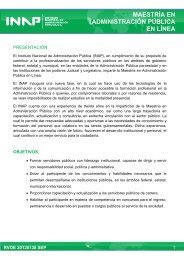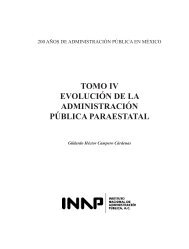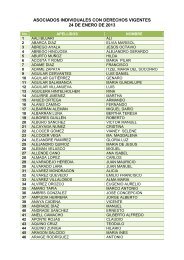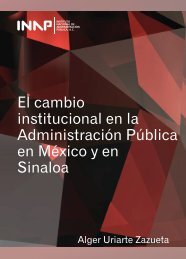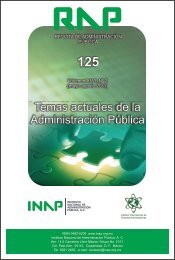Dr. Sunday Akin Olukoju. Faculty/Tutor, Athab - Inap
Dr. Sunday Akin Olukoju. Faculty/Tutor, Athab - Inap
Dr. Sunday Akin Olukoju. Faculty/Tutor, Athab - Inap
Create successful ePaper yourself
Turn your PDF publications into a flip-book with our unique Google optimized e-Paper software.
1COVER PAGEABOUT THE AUTHOR° Author’s name & institutional affiliations:<strong>Dr</strong>. <strong>Sunday</strong> <strong>Akin</strong> <strong>Olukoju</strong>.<strong>Faculty</strong>/<strong>Tutor</strong>, <strong>Athab</strong>asca University; President, Canadian Centre for Global Studies (CCGS).° Contact information:26 Millikin Rd., Winnipeg, MB., R3T 3V4; (204) 296-4514;E-address: solukoju@athabascau.ca; sunday.olukoju@gmail.com
2TITLE PAGEFull title: Leap-frogging using modern information and communication technologies (ICTs)Subtitle: Transferable strategies from the global North to the global SouthAbstractGiven the backwardness and corruption in the global south (Wells & Beynon, 2011;Lalountas et al, 2011), and based on the usefulness of Information and CommunicationTechnologies (ICTs) through e-governance in promoting elements of good governance such astransparency, accountability, participation, social integration (Shampa, 2007), this study seeks touse interview method and comparative analysis (Creswell, 2009) to verify whether there is littleempirical evidence about the interaction of ICT implementations on institutional trust of thepublic sector (Smith, 2011) as well as explore the possibility of promoting transparency andaccountability via "leap-frogging" using modern ICTs to force information into the digital formfor easy access (R. Alcock, personal communication, March 31, 2009). This study’s outcomereveals many opportunities modern ICTs hold in promoting forced disclosure or exposure, andconcludes that ICTs will help the global south leapfrog into accelerated good governance.
3Table of ContentsIntroduction ............................................................................................................................................. 3Background ............................................................................................................................................. 5The high level of corruption across the board ....................................................................................... 7Regime of secrecy and lack of accountability .......................................................................................... 8Recurring public financial mismanagement .......................................................................................... 8Brief Comparative Analysis of Global North and Global South ................................................................ 9Transparency and accountability ........................................................................................................ 11Participation level and social integration ............................................................................................ 12Leapfrogging: Transferable strategies from the global North to the global South .................................... 12Wireless Communication and Information Exchange ......................................................................... 13Deployment of ICTs for Better Security ............................................................................................. 15The Use of Software and Computer Services for Public and Private Sectors ....................................... 16Innovative Better Health Care through e-Health Technologies ........................................................... 16Promoting Research and Development through ICTs ......................................................................... 17Possible challenges ................................................................................................................................ 18Recommendations ................................................................................................................................. 19Conclusion ............................................................................................................................................ 22References ............................................................................................................................................. 24APPENDIX ........................................................................................................................................... 29
4IntroductionWhat is “leapfrogging”, and how could a developing country ‘leapfrog’ after severalyears of snail-speed movement? Can leaders without vision help their countries leapfrog? Theterm “leapfrogging” is defined as “an advance from one place, position, or situation to anotherwithout progressing through all or any of the places or stages in between” (Dictionary.com,“leapfrogging”, n.d., para 2), in this case, this paper’s focus will be on how to leapfrog from abackward, disorganized, and chaotic state of governance to one that is organized and transparent.This study will examine the effectiveness of information and communication technologies(ICTs) in Canada. It is generally believed that “Canada's 30 000 information andcommunications technology firms make over $140 billion in revenues annually”, with a“worldwide reputation” that “is particularly strong in wireless and security technologies, digitalmedia, software and computer services, and e–health.” (Government of Canada, “ICT andCanada: The Future Is Here”, n.d., para 4) Given this background, it is safe to say that Canada, adeveloped country of the global north has been able to make giant strides as a result of its strongICT sub-sector.While Shampa (2007) submits that e-governance highlights several elements of goodgovernance such as transparency, accountability, participation, social integration, publicfinancial management reform and development, Smith (2011) opines that there is little empiricalevidence about the interaction of ICT implementations on institutional trust of the public sector.Hence, this study will carry out a comparative analysis using some of the elements identified asunits of analysis between Canada, a country in the Global North and Nigeria, a country in theGlobal South. As well, Canada will be examined to verify whether e-governance truly facilitates
5an efficient, speedy and transparent dissemination of information to the public. It will examinethe performance of governmental agencies in their administration activities. Consistent with theidea of promoting transparency and accountability via "leap-frogging" using modern informationand communication technologies (ICTs) to force information into the digital form for easy access(R. Alcock, personal communication, March 31, 2009 1 ), this study will review the impact ofmodern technologies in promoting the unconventional approach of forced disclosure or exposure.The intended outcome of this study is to identify effective, innovative and transferableapproaches successfully deployed in the global North that will help combat corruption, changethe regime of secrecy and lack of accountability, as well as mitigate the recurring public financialmismanagement prevalent in the global South.BackgroundGiven the backwardness and corruption in the global south (Wells & Beynon, 2011;Lalountas et al, 2011), and based on the usefulness of Information and CommunicationTechnologies (ICTs) through e-governance in promoting elements of good governance such astransparency, accountability, participation, social integration (Shampa, 2007), this study seeks touse interview method and comparative analysis (Creswell, 2009) to verify whether there is littleempirical evidence about the interaction of ICT implementations on institutional trust of thepublic sector (Smith, 2011) in Canada, as well as explore the possibility of promoting1 The suggestion of using ICTs to help developing countries “leap-frog” came up in my discussion with Hon. RegAlcock, former Canadian Federal Cabinet Minister and Chairman of the Treasury Board, and who was at the time ofour chat, the Dean of the Asper School of Business, University of Manitoba, Canada.
6transparency and accountability in the global south via "leap-frogging" using modern ICTs toforce information into the digital form for easy access (R. Alcock, personal communication,March 31, 2009). An extensive one on one interview with Canada’s former Chair of theTreasury Board will be combined with an extensive comparative analysis of ICT usage ingovernance in Canada with ICT usage in a developing country. Few citizens of the global southwould be interviewed to know their preference on the use of ICT in the global south. Thisstudy’s outcome is expected to be revealing, particularly as many modern ICT opportunities usedin the global north to promote good governance practices are reviewed. This paper intends torecommend some modern ICTs used in the global north to the global south, with the possibilityof promoting forced disclosure or exposure, and most likely help the global south leapfrog intoaccelerated good governance era.Within the Global South, and given the high level of corruption 2 across the board, is therea way to frontally put governance in the public glare where leaders have no hiding place andcitizens are able to closely monitor the way they are governed? Given the level of developmentin the Global North, is it possible to transfer some aspects of the effective, innovative andworkable approaches successfully deployed in its governance structure to combat corruption,change the regime of secrecy and lack of accountability, as well as mitigate the recurring publicfinancial mismanagement prevalent in the global South? Ruhl (2011) differentiated between2 “Unstable governments, often with a legacy of conflict, continue to dominate the bottom rungs of the CPI.Afghanistan and Myanmar share second to last place with a score of 1.5, with Somalia and North Korea - measuredfor the first time - coming in last with a score of 1.” “Corruption index 2011 from Transparency International: findout how countries compare” Retrieved from http://www.guardian.co.uk/news/datablog/2011/dec/01/corruptionindex-2011-transparency-international
7grand corruption by senior officials and petty corruption by lower-level functionaries in CentralAmerican states while drawing the attention of future researchers to possible customizedintervention. Mahmood (2004) concurred regarding the importance of ICTs in enabling citizensand promoting access to information and services, but expressed dismay that only India amongits neighbors is deploying electronic governance in deterring corruption like the majority ofgovernments in the industrialized West.The high level of corruption across the boardCharlotte Denny in The Guardian of 26 March 2004 identified “Australia, Sweden,Switzerland, Austria and Canada” as countries whose “companies are least likely to bribe” (para1). At the same time, the story confirmed that “Mohammed Suharto, Ferdinand Marcos andMobutu Sese Seko ripped off up to $50bn (£28bn) from the impoverished people of Indonesia,the Philippines and Zaire, a sum equivalent to the entire annual aid budget of the west” (Denny,2004: para 2). From the civil service to the executive boardroom and the legislative chambers,corruption is endemic across the board in the Global South. However, the case of post-genocideRwanda is an exception to the rule in Africa south of the Sahara. Rwanda is building a reputationas the foremost African country in the war against corruption, jailing its ministers in the courseof practicing the rule of law, and now reckoned by Transparency International as a less graftriddencountry than Greece or Italy (The Economist, 2012). A country like Nigeria is a case inpoint where corruption has eaten deep into the body politic. The BBC News of April 17, 2012reported how as governor of Delta state, James Ibori sold Delta State's share in Nigerianprivatised phone company, V Mobile (“Former Nigeria governor James Ibori jailed for 13years”). Now serving a 13 year jail term in a UK prison for fraud totalling nearly £50m ($77m),
8his conviction was only possible because the trial was outside Nigeria. This is a classic case ofthe shameless round of corruption going on in the global south. Zafar and McQueen (2011)identified how corruption and neglect have led to a dilapidated health care infrastructure inPakistan, with a resultant surgical care that is largely inaccessible to the poor, especially thoseliving in rural areas. Quite unlike rural dwellers in the Global North, access to moderninfrastructure continues to be a serious problem for rural dwellers in poor countries.Regime of secrecy and lack of accountabilityMost governments in the global south deny their citizens of proper information. Thisgives room for rule changes and re-interpretation of guidelines and procedures, which in turnforces different officials to manipulate the system for personal gains. It also binds the hands ofcitizens who have little or no information to determine what constitutes rights and what falls intothe category of a privilege. Where there is secrecy, there is most likely to be accountabilitydeficit. On a scale of zero to 10 (0-10), the ‘government to citizen’ (G2C) relationship in Africais likely to be below 3. It was Shampa’s (2007) view that e-government needs to be integratedinto the broader public management framework so as to make a substantial change in thegovernment to citizen (G2C) relationship relevant and timely.Recurring public financial mismanagementMismanagement at various levels of government continues to be a cause of concern in theGlobal South. What could easily force a government to lose power like the sponsorship scandalin Canada (CBC News Online, “Federal Sponsorship Scandal”, 2006) will ruffle no feather in theGlobal South. Hammond (2011 July) classified Angola as a classic case of resource curse theory,
9one in which poor countries with large endowments of natural resources and petro dollars revelin corruption, mismanagement, and authoritarianism. However, Hammond also identified theimportance of prevailing political conditions, citing the successful case of Venezuela underChavez that was able to avoid resource curse via a multidimensional approach that combinedhonest governance with sound economic management under a public welfare regime, andserving the interests of the population as a whole in the process.Brief Comparative Analysis of Global North and Global SouthAlthough few examples give a glimpse of hope, it is still premature to start celebratingthe active deployment of ICTs for governance and development in the global south. First is theNigerian government initiated e-agriculture application designed to help the agricultural sector,and the second one is the e-health application designed by the Egyptian Government for freebreast cancer screening of Egyptian women above the age of 45 (Stoiciu, 2011). The thirdexample, based on research and personal interviews of selected representatives of theGovernment of National Capital Territory of Delhi, is the validation of the role of Internet,particularly the World Wide Web (WWW), which has made it easier for citizens to locate anddownload official information and to conduct transactions (Shampa, 2007). However, theexamples here are just the exception to the rule, and about one billion of the planet’s peoplemainly in the global south have no access to ICTs (Stoiciu, 2011). This study shall carry out abrief comparative analysis of global north and global south.While Shampa (2007) recognizes that libraries and knowledge centres should playleading roles in supporting transparent and accountable governance in this digital era, the pointhe omitted was that some individuals, particularly in the global south, are not really interested intransparent and accountable governance, going by their rapacious disposition and kleptomaniac
10tendencies as exemplified in the leadership of Mohammed Suharto of Indonesia, FerdinandMarcos the Philippines, and Mobutu Sese Seko of Zaire (Denny, 2004). It is also doubtful if theyare interested in becoming a part of the technological highway in this digital era. Shampa’s callto have e-government integrated into the broader public management framework in order tomake a substantial change in the government to citizen (G2C) relationship is a timely one,although it takes leaders with foresight to see this.As the governments in the global north continue to play the leading role in enabling thecreation and deployment of accessible e-services and understandable ICT content, the globalsouth should heed Stoiciu’s (2011) suggestion and facilitate the development of a proper andnon-discriminative environment for e-government through the regulatory frameworks, strategicdirections and government guarantees. While the global north is digitally connecting andpromoting international, national, and regional cooperation as reflected in NAFTA and EU 3 , theglobal south is still mired in conflicts 4 The African Union (AU) is unable to resolve the crisisbetween Sudan and South Sudan (Law, 2012), and while Somalia has now become a failed state(Tran, 2012), many other countries like Yemen and Afghanistan 5 in the global south are living in3 López-Guerra, Patricia, n.d., “ICT and labor markets in the NAFTA countries: Commission forLabour Cooperation”. Retrieved fromhttp://info.worldbank.org/etools/docs/library/135820/ICT%20&%20LM.pdf4 Omeje, Kenneth (2008), “Extractive Economies and Conflicts in the Global South: Multi-Regional Perspectives on Rentier Politics”, Burlington: Ashgate Publishing5 BBC News, “Corruption contributes to poverty in Afghanistan – UN”: “It notes thatAfghanistan still has the second highest maternal mortality rate in the world and the third highest
11abject poverty compounded by violence and daily destruction. Just as the global north is usingnew media technologies, such as social networks to promote inclusion, the global south shoulddevelop e-participation and the inclusion of various social categories in policymaking anddecision making, increasing the transparency in decision making and budget spending byimplementing e-services.Transparency and accountabilityThe global south is replete with cases of broken promises and dashed dreams, causing ahuge trust deficit for governments. Torres et al (2006) rightly identify the issue of trust and howInternet aids could be deployed to build it in the twenty-first century. Torres et al’s description oftechnology as an enabler within preexisting social and political structures supports Reg Alcock’s(2009) leapfrogging idea. Not only would it aid good governance via increased transparency andcustomer-oriented service delivery, it will force information like contracts awarded, the biddingprocess, the eligibility criteria and names of contractors into the easily accessible World WideWeb. Despite the example of how European Union local governments deploy the Internet for e-governance, Torres et al confirm that the Internet has to be improved to facilitate democraticinputs into the policymaking process. Rural dwellers in the global south would need a lot oftraining.rate of child mortality. (2010, Mar 30: para 8) Retrieved fromhttp://news.bbc.co.uk/2/hi/8595258.stm
12Participation level and social integrationDocksai (2011) reports on the growing role of cell phones and other handheld devices forInternet access in empowering disadvantaged communities and enhancing democracy. The 2008US elections experienced a huge surge as young people connected via social networks and otherICT tools. Elections in Nigeria are still fraught with crisis and chaos as telecommunications arestill not functioning at the highest level. Stoiciu (2011) rightly identified a gap betweenknowledge-based and rudimentary societies despite the stout acknowledgement of the need toincrease the level and depth of all stakeholders' participation both in implementing e-governanceprocess and in decision making in all societies.It simply follows therefore that just as it takes two to tango, e-governance must beaggressively patronized by citizens and all other stakeholders if it must be functional andproductive. The article reports the significance of e-governance to bridge the gap betweenknowledge-based and rudimentary societies in the U.S. It discusses the factors that cause theincreasing gap in digital divide including low income, lack of digital literacy and limited accessto quality information and communication technologies (ICT) content. These are commonproblems in the global south. Developing e-governance such as the use of mobile communicationin disseminating electronic services therefore becomes imperative.Leapfrogging: Transferable strategies from the global North to the global SouthOf the 32 individuals asked to share their opinion on the idea of helping global southleapfrog, preference vary, but most were united on the use of e-security ICT tools (see Table onpage 29). The global north promotes openness and transparency at every opportunity. Aspen
13Institute refers to the policy papers “that call on community and elected leaders to adopt sensiblestrategies to expand government transparency”, as well as making “public records and civic datamore open and accessible to the public, and create local online hubs that provide maps for acommunity’s information resources.” (“New Policy Papers Call for Adoption of Strategies toExpand Government Transparency and Create Online Hub”, n.d.: para. 1) In the globalsouth, it is doubtful if leaders and opinion molders are thinking or talking of strategies toexpand transparency or ways to make public records open and accessible to all. And withthe low literacy level in the global south coupled with the limited access to ICTs,particularly in rural areas of the global south, the idea of creating a local online hub, greatas it sounds, may be less important to the rural dwellers than access to daily source oflivelihood. In discussing some ICTs that are positively deployed in the global north, thispaper would explore the possibility of transferring some of the tools to help the globalsouth leapfrog. The idea of leapfrogging is to eliminate merry-go-round and shorten thejourney to development. Access to information and easy communication is one way theglobal north continues to engender progress and development. A country like Canada, withhuge expanse of land is able to communicate with rural dwellers in the remotest parts ofthe country. Next, this paper will discuss few of the several ways ICTs have beensuccessfully deployed in Canada.Wireless Communication and Information ExchangeInformation is power and through wireless technologies, Canada is able to disseminateinformation quickly and communicate both at the governmental level and at the business orprivate level. ICTs are becoming useful tools of learning. In their analysis of the relationship
14between information and communication technology (ICT) and scientific literacy in Canada andAustralia, Luu and Freeman (2011) found a positive correlation. According to their study, thosewho browse the Internet more frequently, and who are confident with basic ICT tasks earnedhigher scientific literacy scores. Canada’s innovative wireless technologies and applications suchas WiFi, WiMAX and mesh networks, ultra–wideband and radio frequency identification, andsoftware-defined radio (Government of Canada, “Capitalize on Canada's Technology Strengths”,n.d.) are modern ICT tools deployed to make life easy across sectors – public, private, non-profitand even at the kith and kin levels. Citizens are able to interact with public servants and access tothe World Wide Web is easy. The high level of corruption in the global south (Soliman & Cable,2011) could be reduced or eliminated if public spending, budget, assets declarations and everyother important information are forced into an accessible digital storage for citizens to monitor.While Canada hosts many of North America's fastest-growing wireless companies, the globalsouth is not pulling its weight in investing resources in such areas, save for India 6 . Nigeria’sstory changed a bit when the country joined the wireless telephone system in the early years ofthe 21 st century and was able to have a working telephone system during the Obasanjo regime,enabling the country to leapfrog from zero mobile telephone by December 1999 to over 25million mobile phones by June 2006 7 , thereby leapfrogging over the ‘never-working’ but now6 “Tata Communications pulls out of GBP1bln battle for Cable & Wireless Worldwide”(2012 April 20). Retrieved from http://indiatelecomnews.com/?p=20117Salawu, Bashiru, A. (2008) “ICTs for sustainable development: The Nigerian experiment”,Information, Society and Justice 1.2: 115-135. Retrieved fromhttp://www.londonmet.ac.uk/library/w44430_3.pdf
15defunct NITEL (Nigerian Telecommunications Company). The era of wireless communication inNigeria may have contributed to a better security network as armed robbers now know that eachhousehold has the means of contacting law enforcements officials before they finish theiroperation. But there are also direct tools for security in use in the global north as well.Deployment of ICTs for Better SecurityMany states in the global south like Nigeria, Somalia, Yemen, Syria, and Pakistan (Maclean,2010) are struggling to contain internal chaos and strife due largely to the state of insecurity.Also, due to poor IT security in the global south, IT use and utility are becoming unproductive.Hence, global south should seek to deploy IT security like Absolute Software, ForensicTechnology and OKIOK used in the global north. Through the use of effective security hardwareand software, Canadian government continues to provide security for its citizens. For example, apolice cruiser car is well equipped to read the bio data simply by entering the plate number of aregistered vehicle. All police cruisers are equipped with monitoring devices and powerfulcommunication equipment for maximum security. Hence, the global north is able to secure livesand properties through the use of tracking devices and bullet proof cars, in addition to advancedapplications in biometrics, cryptography and encryption, mobile authentication, cybersecurity,public safety and product certification from Canadian companies such as KolomboTechnologies, Optosecurity, MXI Security and Q1 Labs (Government of Canada, “IT Security:Making the World More Secure”, n.d.) The global north is very proactive in its thinking andplans, and the global south could adopt this approach.
16The Use of Software and Computer Services for Public and Private SectorsIn a world where the forces of supply and demand determine the price and productpreference, it is only reasonable to know that doing business has to change. Just as the globalnorth, the global south should deploy cost–effective ICTs to ensure competitiveness as well asmaintaining the highest quality in products and services. Many crown corporations governmentalagencies are doing well because of the modern ICTs like IBM-Cognos and Business Objects-SAP for business intelligence, Open Text Corporation for enterprise content management,Descartes, TECSYS for supply chain management, and Mediagrif Interactive Technologies fore-commerce. These are used within the industry and vertical markets (Government of Canada,“Software and Computer Services: Strengths Across the Sectors”, n.d.).Innovative Better Health Care through e-Health TechnologiesHealth is wealth, and the life expectancy in the global north 8 is something worthemulating by the global south. For example, Canada's advanced e-health technologies continueto deliver the highest quality of health care while keeping health costs as minimal as possiblewhile deploying the tools that provide the best practices in proactive clinical systems, hospitaland physician office resource management systems, long-term and acute care, telemedicine, andhome and community care, with companies such as Emergis (a TELUS Company), CLINICARECorporation, MED2020 Health Care, Logibec Groupe Informatique, Nightingale InformatixCorporation, MediSolution and Momentum Healthware as huge part of the Canadian health care8 UN puts the Canadian women and men ages at 83 and 79 respectively; while Nigeria’s life expectancy is 53 and 52respectively; Afghanistan is 49 for women and men while Somalia’s life expectancy is 53 and 50 respectively.Retrieved from http://unstats.un.org/unsd/demographic/products/socind/
18Canada's primary laboratory for R&D in advanced telecommunications, and the only nationallaboratory with critical mass and expertise in wireless, broadcasting, satellite and fibre optics,components and systems. (Government of Canada, “Home to World-Class Research andDevelopment”, n.d.) The global south will need to adopt the proactive approach of the globalnorth in deploying ICT resources to drive good governance. As well, it should endeavor to investin research and development to maintain the tools and improve on the techniques based onchanging times.Possible challengesHaving necessary infrastructure to support ICTs could be a serious challenge in theGlobal South. For example, constant power interruption as prevalent in Nigeria 9 will frustrate theidea of functional ICTs. Deliberate sabotage by those who feel threatened by the forcedtransparency of ICTs usage is another possible challenge to deal with.The cost of acquiring functional ICTs is one thing, but the cost of maintaining theequipment is another thing altogether. Global South may not have the maintenance culture of theGlobal North, and may end up acquiring what could end up being abandoned.Functional institutions and visionary leadership necessary to drive a productive ICTsintervention are few in the global south. The high level corruption in the global south is another9 Osuagwu, Nkem (2012 Jan 29) “Nigeria: Nama Laments Constant Power Outage at Port-Harcourt Airport”,AllAfrica. Retrieved from http://allafrica.com/stories/201201301879.html
19serious issue to deal with. Without adequate funding earmarked for necessary infrastructure, thewhole idea of acquiring ICTs will be a mirage.It has also been suggested that cyber-bullying (Patchin & Hinuja, 2009), phishing Jøsanget al. (2007) and masquerading (Stone, 2007) are potential dangers of ICTs. Phishing andmasquerading have reared their ugly heads in the form of advanced fee fraud in Nigeria, codenamed“419”. Hence, the need to have a reliable policing system in place is non-negotiable if theICT tools must deliver the good governance promises in the global south.RecommendationsLeapfrogging through information and communication technologies (ICTs) couldfiguratively transport the Global South in general, and Africa south of the Sahara in particularfrom the secrecy within a mud and brick house with its accompanying crooked ways of doingthings into a transparent and reflective glass house where government activities are in the open,and subject to permanent public analysis and assessment. For example, all contracts and namesof contractors, including the processes and procedures guiding the contract allocation should beopenly displayed digitally for easy access. This will force contractors to deliver. It will alsohinder the civil servants from the habit of protecting contractors who abandon paid governmentprojects.Given the high level of official corruption both at the political as well as the civil servicelevels of government, every official of government must declare their assets, and the documenteddetails should be held digitally for citizens’ easy access. The idea is to know what new assets areacquired recently, and whether the funds were secured legitimately or not. It could trigger new
20investigations if citizens realize inadequacies in the list declared by the politician or publicservant.With the prevailing confusion or lack of information on how to access services, allofficial application forms for all government services should be held digitally for easy access.This will prevent the prevailing commercialization of ordinary forms at the civil service level.Also, the online information should contain all necessary fees required for each service. This willprevent over-invoicing and unreasonable demands by corrupt government officials. Another wayto leapfrog is to plug loopholes for corruption. Like the Canadian experience where most formslike the Manitoba Provincial Nominee Program application 10 could be completed and submitteddigitally without the applicant meeting the officer processing the application, the temptation todemand bribes from applicants is reduced. This is in addition to monitoring and tracking atvarious levels, and because there is a deadline for application approval or rejection outcome, thelevel of efficiency and effectiveness does increase. This will be a good way to go in thedeveloping world or the global south.As education continues to be the wheel driving progress and development in the GlobalNorth, and based on the positive result of online education, the Global South should explore thatoption as well. This will empower the massive population especially now when development ishinged on knowledge-base of a society. Through continued education via online learning,employees are encouraged to go for professional development and avail themselves of modern10 Government of Manitoba Immigration website (n.d.) “How to use the MPNP online application tool” Retrievedfrom http://www.immigratemanitoba.com/how-to-immigrate/how-to-apply/
21approaches to resolve issues of public importance. The option of tracking and or remotemonitoring that ICTs offer would be an effective approach to ignite efficiency as civil servants’accomplishments would be measured annually via digitally facilitated appraisal methods.In addition, ICTs should be used to promote intergovernmental cooperation andcollaboration within and between departments and governments. For example, a general portalcould hold relevant information that should be made accessible to relevant departments. Theissue of certificate of occupancy is a notorious one in Nigeria. If a digital database holds allnecessary information that could be accessed by officers in Lands and Housing as well as theJudiciary, a certificate of occupancy would be issued within days instead of years. When theprocess and procedures are clearly stated, and the relevant costs openly displayed, digitalprocessing could remove the face to face interaction between public servants and citizens. Forexample, in the global north, and citing Canada as a good example, one can pay bills on line forservices like power, water, Internet and cable among many others.Jon Gant and Nicol Turner-Lee’s 11 six strategies for more open and participatorygovernment are necessary reminders for the global south. The first one is to bring together thechief information and technology leaders to determine more effective technical and operationalprocedures for open government purposes. This is particularly relevant in the global south whereprocedures are largely non-existent. The second one is the creation of sustainable public-privatepartnerships for developing public goods applications. There has to be a sustainable cooperation11 Gant, Jon and Turner-Lee, Nicol (2011 Feb 25) “Government Transparency: Six Strategies for More Open andParticipatory Government”. Retrieved from http://www.aspeninstitute.org/publications/government-transparencysix-strategies-more-open-participatory-government
22and collaboration in the global south for the citizens of the different states to enjoy the benefitsof ICTs. The level of corruption within the public sector in the global south could be a dent onthis proposal. The third one is the establishment of more flexible procurement procedures, offthe-shelfpurchasing and easier contracting for the technologies used to disseminate governmentinformation. The fourth is the improvement of broadband access to community anchorinstitutions. The fifth and the sixth recommendations involve the creation of government contentthat is relevant and accessible to all populations; and the promotion of new partnerships forprofessional development that leverage industry and university knowledge within government.The fifth point is particularly important as the information must be relevant to the people, timely,and easily accessible.Stoiciu’s (2011) proposals for bridging the digital divide are also relevant here. It isimperative to harmonize the legal framework and regulation; and ensure that there is a minimumpackage of interconnected and interoperable e-services. Also, it is important to promote ICTskills and digital literacy in a non-discriminative manner, with suitable ICT content and by usingnew media technologies, such as social networks particularly in both urban and rural areas of theglobal south. For the global south to leapfrog, the use of mobile communication as infrastructurefor the dissemination of e-services must be intensified.ConclusionThere has to be attitudinal changes in the global south if the gains of ICTs are to bepositively used to leapfrog. The high corruption must be reduced, and the reluctance to hang onto traditional ways of doing things must be forsaken. Reg Alcock had alluded to the issue ofparliamentary oversight in Canada, and how holding information digitally could help in financial
23oversight. Stoiciu’s (2011) submission that the provision of suitable e-services and the promotionof digital literacy should become a security matter and a top priority for governments is a timelyone, as this will ensure their country or region has a place in the future knowledge based society.The global south must therefore acknowledge that the new era is knowledge based, hence,ongoing training must commence. And because a tool of construction could become aninstrument of destruction in the hands of criminals, adequate care must be taken to ensuremaximum protection against hackers and other criminals. Schware (2005) outlined someguidelines for successful ICT enabled projects: suitability to a country’s level of development;relevance to targeted users’ needs; integration with infrastructure, applications, and skillsdevelopment; design and implementation must be in sync with institutional and business processchange process; handled as a part of national development strategy; as well as regular monitoringand evaluation. Most important of all, ICTs must be purpose-driven with adequate training andmaintenance built into the whole process.
24ReferencesBBC World News Online (April 17, 2012). “Former Nigeria governor James Ibori jailed for 13years”. Retrieved from http://www.bbc.co.uk/news/world-africa-17739388CBC News Online (October 26, 2006). “The Federal Sponsorship scandal”. Retrieved fromhttp://www.cbc.ca/news/background/groupaction/Creswell, John (2009), Qualitative, quantitative, and mixed methods approaches. ThousandOaks: Sage PublicationsDenny, Charlotte (2004 26 March), “Suharto, Marcos and Mobutu head corruption table with$50bn scams”, The Guardian Online, retrieved fromhttp://www.guardian.co.uk/world/2004/mar/26/indonesia.philippinesDictionary.com (n.d.). Leapfrog. Retrieved fromhttp://dictionary.reference.com/browse/leapfrog?s=tDocksai, Rick (2011) “Connecting People to Their Governments”, Futurist 45(6): 12-13Government of Canada (n.d.). ICT and Canada: The Future is here. Retrieved fromhttp://investincanada.gc.ca/eng/publications/ict-canada.aspx#ict2Hammond, John L. (2011 July), “The Resource Curse and Oil Revenues in Angola andVenezuela”, Science & Society, 75(3): 348-378.
25Jøsang, Audun, AlFayyadh, Bander, and Grandison, Tyrone (2007) “Security UsabilityPrinciples for Vulnerability Analysis and Risk Assessment.” (PDF). Proceedings of theAnnual Computer Security Applications Conference 2007 (ACSAC'07). Retrieved fromhttp://persons.unik.no/josang/papers/JAGAM2007-ACSAC.pdfLalountas, Dionisions A., Manolas, George A. and Vavouras S. (2011) “Corruption,globalization and development: How are these three phenomena related?”, Journal ofPolicy Modeling 33(4): 636-648Law, Tom (2012 May 2), “South Sudan asks IGAD to help AU resolve conflict with Sudan”,Sudan Tribune. Retrieved from http://www.sudantribune.com/South-Sudan-asks-IGADto-help-AU,42460Luu, King and Freeman, John (2011) “An analysis of the relationship between information andcommunication technology (ICT) and scientific literacy in Canada and Australia,”Computers & Education 56(4): 1072-1082Maclean, William, (2010 Nov 15) “Somalia tops terrorism risk list, India danger down”, ReutersLondon, Retrieved from http://in.reuters.com/article/2010/11/15/idINIndia-52911020101115Mahmood, Rumel (2004), “Can Information and Communication Technology Help Reduce
26Corruption? How So and Why Not: Two Case Studies from South Asia”, Perspectives onGlobal Development & Technology, 3(3): 347-373.Patchin, J.W. and Hinuja, S. (2009) Bullying Beyond the Schoolyard: Preventing andResponding to Cyberbullying, Thousand Oaks: Sage Publications.Ruhl, J. Mark (2011), “Political Corruption in Central America: Assessment and Explanation”,Latin American Politics & Society, 53(1): 33-58.Schware, Robert (2005) Overview – E-Development: From Excitement to Effectiveness,Prepared for the World Summit on the Information Society Tunis, Retrieved fromhttp://wwwwds.worldbank.org/external/default/WDSContentServer/WDSP/IB/2005/11/08/000090341_20051108163202/Rendered/PDF/341470EDevelopment.pdfShampa, Paul. (2007). A case study of E-governance initiatives in India. InternationalInformation & Library Review, 39(3/4): 176-184.Smith, M. L. (2011). Limitations to building institutional trustworthiness through e-government:a comparative study of two e-services in Chile. Journal of Information Technology(Palgrave Macmillan), 26(1): 78-93.Soliman, Hussein and Cable, Sherry (2011) “Sinking under the weight of corruption: Neoliberalreform, political accountability and justice”, Current Sociology 59(6): 735-753
27Stoiciu, Andreea (2011) “The Role of e-Governance in Bridging the Digital Divide”, UNChronicle 48(3): 37-39.Stone, Brad (July 16, 2007) "The Hand That Controls the Sock Puppet Could Get Slapped". NewYork Times. Retrieved fromhttp://www.nytimes.com/2007/07/16/technology/16blog.html?ex=1342238400&en=9a3424961f9d2163&ei=5088&partner=rssnyt&emc=rss.The Aspen Institute, n. d. “New Policy Papers Call For Adoption of Strategies to ExpandGovernment Transparency and Create Online Hub” Retrieved fromhttp://www.aspeninstitute.org/news/2011/02/25/new-policy-papers-call-adoptionstrategies-expand-government-transparency-create-onlThe Economist (Feb 25, 2012), “Africa's Singapore?”, 402 (8773): 80-80.Torres, Lourdes; Pina, Vicente, and Acerete, Basilio (2006) “E-Governance Developments inEuropean Union Cities: Reshaping Government's Relationship with Citizens”,Governance 19(2): 277-302.Tran, Mark (2012 February 12), Somalia: a failed state where intervention carries its own risks.Retrieved from http://www.guardian.co.uk/global-development/2012/feb/22/somaliafailed-state-intervention-risksWells, Peter and Beynon, Malcolm (2011) “Corruption, automobility cultures, and road traffic
28deaths: the perfect storm in rapidly motorizing countries?”, Environment & Planning A43(10): 2492-2503Zafar, Syed and McQueen, Kelly (2011, Dec), “Surgery, Public Health, and Pakistan”, WorldJournal of Surgery, 35( 12), 2625-2634.
29APPENDIXAreas of Preference in ICT Use in the Global South# e-services e-security e-governance e-health e-education e-commerce1810 (VI) 14 (MI) 5 (I) 7 (I) 12 (VI) 10 (LI)females1410 (VI) 12 (MI) 9 (VI) 5 (I) 8 (VI) 10 (VI)males32 20 (VI) 26 (MI) 20 (VI)Of the 32 individuals interviewed from the global south, over 81% rated e-security as the ‘mostimportant’ (MI) reason for wanting ICT tools, while another 62.5% rated e-services and 67%rated e-education as ‘very important’ (VI) ICT tools preferred in the global south. (Where LIstands for ‘least important’ and I for ‘important’)




